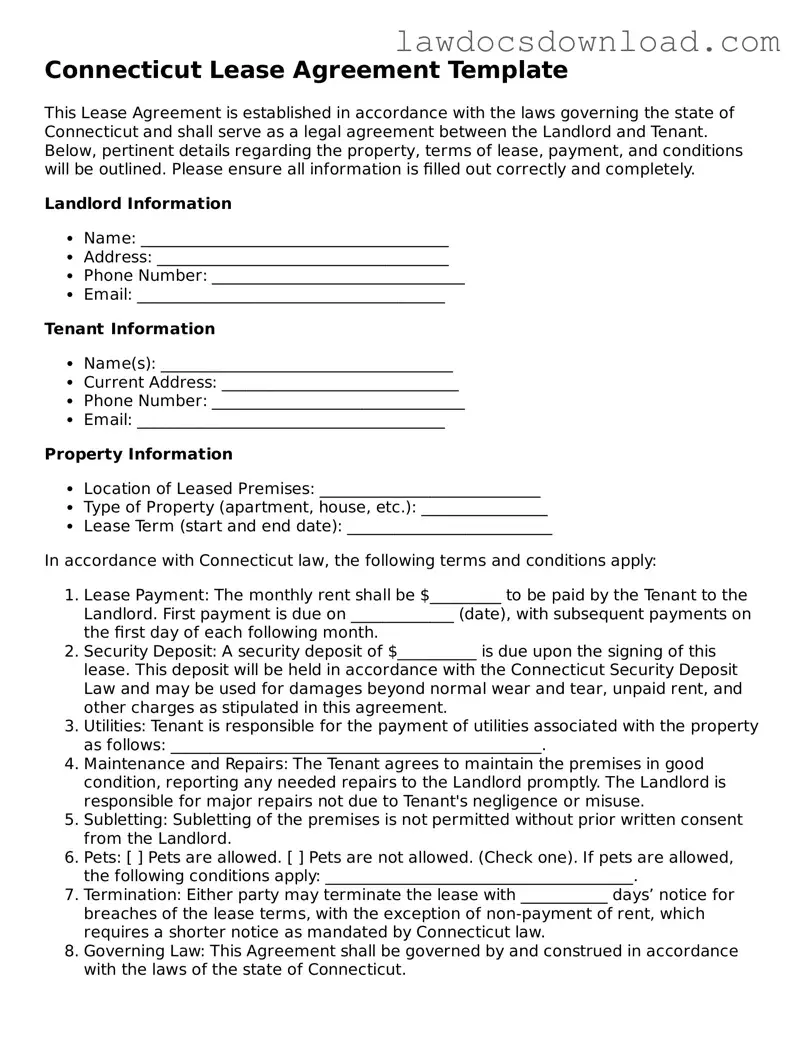One common mistake people make when filling out a Connecticut Lease Agreement is not specifying the lease term. The start and end dates of the agreement are crucial for establishing the duration of the lease. This oversight can lead to misunderstandings about how long the tenant has the right to occupy the property. Ensuring these dates are clear and correct is essential for both parties' planning and legal obligations.
Another error often encountered is failing to detail the payment terms, including the amount of rent, due dates, and methods of payment. This lack of clarity can result in late payments or disputes over rent amounts. It's important to specify not only the monthly rent amount but also when and how payments should be made to avoid these issues.
Many individuals also neglect to include information about the security deposit. This includes the amount, the conditions under which it will be held, and the terms for its return. Forgetting to outline these details can lead to legal conflicts at the end of the lease term over deductions or the timing of the deposit's return.
Overlooking the need to specify rules about alterations or improvements to the property is another frequent mistake. Without explicit permission or restrictions detailed in the lease, tenants may assume they can make changes to the property, which can lead to disputes. It's critical to clearly state what is or isn't allowed in terms of property modifications.
A significant error often made is not addressing the subletting policy. Without a clear statement regarding whether the tenant is allowed to sublet the property and under what conditions, property owners may find themselves with unauthorized occupants. Clarifying this within the lease can prevent potential issues with unwelcome subtenants.
Forgetting to list all tenants is a common oversight. This mistake can lead to certain individuals living in the property without being legally bound by the lease terms, complicating issues such as eviction or rent collection. Ensuring that every adult occupant is named in the lease helps bind each tenant to the agreement's obligations and protections.
Failing to include or improperly outlining the landlord's entry rights can also be problematic. The lease should clearly explain the conditions under which the landlord may enter the premises, typically for repairs or inspection, ensuring respect for the tenant's privacy while maintaining the owner's right to access the property.
The lack of a detailed pet policy is another error that can lead to disputes. Whether pets are allowed, what types, and any associated fees or deposits should be explicitly stated. Without this clarity, disagreements over pet ownership can emerge, possibly putting the tenant or landlord at odds.
Overlooking the need to detail the maintenance and repair responsibilities can also create future conflicts. It is vital to clearly assign who is responsible for what aspects of property upkeep to prevent disagreements and ensure the property is maintained properly.
Finally, not providing instructions for renewing or terminating the lease is a crucial detail that many fail to include. This information guides both parties on how they can extend their agreement or part ways at the lease's end, helping to avoid last-minute confusion and legal issues.
